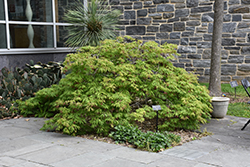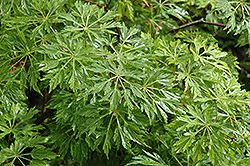Plant Library
Green Cascade Maple
Acer japonicum 'Green Cascade'
Height: 30 feet
Spread: 30 feet
Sunlight:
![]()
![]()
Hardiness Zone: 6a
Description:
Makes an exceptional landscape accent; may need staking when young to encourage weeping habit; keep moist as leaves tend to scorch in heat; brilliant yellow to orange/red fall color; attracts nesting birds; water more if grown in full sun
Ornamental Features
Green Cascade Maple is primarily valued in the landscape for its ornamental globe-shaped form. It features dainty corymbs of red flowers hanging below the branches in mid spring. It has attractive dark green deciduous foliage. The serrated lobed palmate leaves are highly ornamental and turn outstanding shades of yellow, orange and scarlet in the fall.
Landscape Attributes
Green Cascade Maple is an open multi-stemmed deciduous tree with a more or less rounded form. Its relatively fine texture sets it apart from other landscape plants with less refined foliage.
This tree will require occasional maintenance and upkeep, and should only be pruned in summer after the leaves have fully developed, as it may 'bleed' sap if pruned in late winter or early spring. It has no significant negative characteristics.
Green Cascade Maple is recommended for the following landscape applications;
- Accent
- Mass Planting
- Hedges/Screening
- General Garden Use
Planting & Growing
Green Cascade Maple will grow to be about 30 feet tall at maturity, with a spread of 30 feet. It has a low canopy with a typical clearance of 3 feet from the ground, and should not be planted underneath power lines. It grows at a slow rate, and under ideal conditions can be expected to live for 60 years or more.
This tree does best in full sun to partial shade. You may want to keep it away from hot, dry locations that receive direct afternoon sun or which get reflected sunlight, such as against the south side of a white wall. It prefers to grow in average to moist conditions, and shouldn't be allowed to dry out. It is not particular as to soil type or pH. It is quite intolerant of urban pollution, therefore inner city or urban streetside plantings are best avoided, and will benefit from being planted in a relatively sheltered location. Consider applying a thick mulch around the root zone in winter to protect it in exposed locations or colder microclimates. This is a selected variety of a species not originally from North America.



